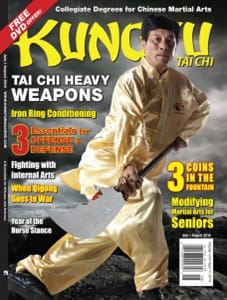I have come to be in awe of the high level of sophistication and intelligence that has gone into a proper tai chi warm up set. No matter where a person is mentally, energy-wise, physically, or emotionally, correctly organized tai chi warm up exercises have the power to bring everyone to the same calm center before the form practice begins.
Tai chi warm up sets are a series of exercises that concentrate on rotating the joints for nine or more repetitions to simultaneously warm up the muscles on both sides of the joint and release synovial fluid in the joint. They work from toe to head or vice versa and cover the entire body.
I have witnessed this time and again as everyone arrives at class in a very different place. Some are tired. Some have had way too much coffee. Some are stressed. Some are distracted. Many are excited. Everyone relaxes to the same place before starting the form. More importantly, some class members are beginners and some are seniors and we never have injuries.
Don’t excuse yourself from this analogy
I (you!) arrive at each class in a very different place. My class begins at 7PM and there are times I put my head on the steering wheel at 6:45 in the parking lot just to close my eyes for a few minutes. Some days I am totally pumped! Some days (more than I want to admit) I drank coffee too late in the day and am still not settled down with bedtime right around the corner.
And yet, 30 minutes into class I have moved away from the jittery/tired/stressed/pumped state and have become the upright, calm, deep breathing person I always aspire to be.
This is HUGE so let me talk about it in a different way so that the power of a good warm-up set sinks in. Most everything we do in the western world sends us cascading too far in the direction we want to go and we miss the mark. Inevitably, we come swinging back to where we began.
Tired? We drink Red Bull and fry our adrenal glands
Stressed? Drink alcohol
Emotional? Call a friend and relive a horrible event (mentally) again and again.
Don’t get me wrong, there is nothing wrong with caffeine, alcohol, or friends. It’s just that our solution to the problem puts us on a pendulum swinging way out to the other extreme.
What we really want is to get to the middle.

The Yin Yang of Tai Chi Class
Imagine everyone standing in a circle around a huge tai chi symbol. Each person represents an extreme – tired, stressed, etc. The goal is not to get anyone across the circle to mirror their opposite, it is to get everyone in the room into that center calm place. In our class we actually warm up in a circle facing each other.
Calmness is a hard sell
A calm, balanced, energized, sense of capacity sounds great but when it is put up against the immediate experience of alcohol or caffeine it pales in comparison. To get around this we need to actively measure the change that occurs. As an example, this is what I often say right at the beginning of class.
Everyone in this room brought different energy with them into this class.
Take a minute and think about where you are at. Are you stressed? Tired? Amped up? Bored?
(add personal example) I got up at 5 today and had a really full day so I am actually a bit tired.
On a scale of 1-10, how stressed/tired are you?
Remember this number because after we are done with the tai chi war -up set and qi gong I want you to check back in with yourself and see how you are feeling and how far you moved the needle.
Here is the beautiful thing about Tai Chi: It doesn’t matter where you are because all of our jobs are the same. The movements will ring the tension and stress out of your tissue and push it into your blood. All movements begin from the floor so this will also ground you. Your job is to breath deeply and fully. If you are feeling tense, this will calm you. If you are tired this will oxygenate your blood.
Basic Principles For a Tai Chi Warm Up Set
If your tradition has a specific sequence of movements, stick with it. However, so many classes see Silk Reeling, Qigong, and the tai chi warm up set as the things that are keeping them FROM the Good Stuff. I think this IS the Good Stuff!
This isn’t to say that all martial arts classes are this way. I have a friend who studies a Japanese Jujitsu style and they have retained a series of movements that are carried out each practice before getting to the “good stuff.” But I also know that several members of that school have traveled to Japan to study and learn in the original dojo.
I remember being bored at one of the first tai chi workshops that I attended and even questioned whether the weekend was a good use of my money – because “all we were doing was stretching – for a VERY LONG TIME!”
The more I study in China, interact with people who have studied in China, or learn from Chinese instructors, the more value I see in the tai chi warm up set. And ALL accomplished practitioners do it, ever time, same routine. Not only that, the benefits of tai chi are felt because it is repetitious. It is designed into the sets.
1. Take it Seriously
Stretching in tai chi is taken extremely seriously. People want “skills” and want to “get to the good stuff” but inherently, the ones who have the skills and demonstrate the good stuff are highly proficient at whole body, integrated movement.
2. It is about 50% concentration and 50% stretching
We are initiating from the ground on every stretch including the wrists. Using the set below as an example, this would give you 153 opportunities to direct the force from the ground (17X9). High repetition is essential to change patterned movement.
3. Move in a direction from head-to-toe or toe-to-head
This ensures that you stretch everybody part and that the stretching is a slow unfolding of the body’s flexibility and strength. Chen Youze teaches from bottom to top. Many traditions do the reverse. He did not share opinions about stretching from top down but sees all stretching and qi gong as serving the purpose of building “root” and improving posture and stance. It therefore serves that working your way up encourages connection to the ground.
4. Do 9 repetitions of each exercise
Choose one number so that it is the same for all the exercises so that you can concentrate on the movement and not thinking about the counting. It has to be enough repetitions so that you feel a light fatigue from moving the muscle by the time you stop. Most traditions use 9 repetitions.
5. No static stretches!
For each exercise we are relaxing a joint and using the muscles on each side of the joint to rotate the joint. We are rotating through the joint several times in a continual movement with a slight pause in between repetitions. I wrote a separate essay on tai chi stretching which is great read if you come from a western sports background. Tai chi warm ups are theoretically opposite from western methods of locking a joint and pulling the muscle tight and holding.
Tai Chi Warm up Exercises Chen Style: as taught by Master Chen Youze (CY)

For those of you that need to add something to the beginning of your class or round out your current routine, here is an example of tai chi warm up exercises Chen style taught by Master Chen Youze. During a workshop and a US visit he did interviews with Kung Fu Magazine explaining the importance of warm ups, stretching, and standing meditation. This is how he begins every training session.
Warm Up Exercises
- Raising On To Toes Into Prayer Hands
- feet ~6 inches apart
- raise hands out to side, palms up
- Palms end in prayer hands, overhead, arms extended
- Rise up onto toes and arch backwards pointing fingertips at back wall
- Lower to heels and bring hands back up overhead
- Hands separate and decent to the sides palm down
- Hands meet with fingers pointing at floor in prayer hands
- Bend at the waist until finger tips touch the floor
- Bend knees and slowly stand
- Release hands to side
- Ankle Rotation
- Place right toe on ground straight back at about the distance of where the left heel ends
- Relax ankle
- Rotate ankle to the outside
- Repeat on left side, only rotating to the outside
- Knee Rotation
- The knees are stretched by using the muscles of the calf and hamstring to rotate the knees by lowering yourself in and out of a sitting position. Just like with the ankles, image that the knee joints are very loose.
- Place the palms over the knee caps
- Relax the lower back
- Sit as though you were lowering yourself on a chair
- Rotate the knees counter clockwise
- Sitting and pushing back up with each revolution
- Repeat in other direction
- Groin and Lower Back Stretch
- Squat down on your heals, heals remain on the floor
- Interlace your hands and put them below your chin, not touching your chin
- Press out on the outsides of your forearms into the inside of your knees
- Press with the inside of your knees on your forearms until they are parallel
- Do not pick up the rear heel
- You should feel a stretch across your lower back
- Kua (Hip) Opening
- Think about your right heel
- Soften your lower back
- Imagine you are sitting on a bar stool and instigate raising your left leg until your thigh is parallel with the ground
- Rotate your thigh outward and then release the leg back down
- Each repetition should begin with a soft lower back and a sitting motion
- The standing knee is slightly bent, hands at the side
- Hip Circles Exercise
- The lower back and muscles of the pelvis are warmed up with a hip circles exercise
- Place your hands on your obliques
- Rotate your tailbone like you are drawing a circle on the ground
- Keep the upper body calm, you chest and back should not be circling.
- Waist Turns (includes calves)
- The waist is stretched by rotating sideways into a posture that resembles a discus thrower
- Feet are wider than shoulder width apart
- Hands extend out from the side, palms down
- Rotate all the way around to the right and look at the back left heel
- Palms remain facing the floor
- Rotate back around to the left and look at the back right heel
- You should feel a stretch across your back and your calf
- Shoulder Rolls
- Shoulder rolls warm up upper torso by opening and closing the chest and back. We initiate and end in the feet. Arms are completely relaxed.
- Think about your heels
- Relax your back
- Push up from the heels through your spine and open the chest to rotate the shoulders towards the back back
- Pause at the bottom
- Continue your shoulder rolls by rotating backwards, always pushing from the heal
- Repeat in the other direction by pushing up through the back and closing the chest to come around and produce shoulder rolls to the front
- Elbow Stretch
- The elbow is stretched by bringing both hands up close to the body and then flicking them out and forward
- Raise hands palm up
- Bring them in to the breast line against the body
- Turn your hands over – to the inside – and flick forward
- You should end with the arms extended, palms down
- Wrist Stretch
- Interlace fingers, palms together
- Loosen wrists
- Rotate wrists quickly making circles
- This is awkward at first because the wrist does not relax easily
- If this is the case start by turning the back of each hand to the floor and then changing to the back of the other hand
- Neck/Head Stretch Forward
- Relax the head down
- Pause and you will feel a nice stretch down your back
- Use your back muscles to bring the head up and back
- Look at the ceiling, mouth open
- You should feel a nice stretch down the front of your neck
- Contract the chest muscles to initiate moving the head forward again
- Repeat
- Neck/head stretch side-to-side
- Lay your right ear on your right shoulder
- Stretch through your left finger tips
- Slowly rotate your left ear to your left shoulder
- Your hands are at your side and may rise and far ~ 1 inch but not a lot
- Whole body
- Stand with arms extended out to the sides palm up
- Curl the right hand over to where the finger tips are on the shoulder
- Move the right hand down so that the back of the hand is by the right armpit
- Raise the left hand high and image sticking your fingers into where the wall meets the ceiling
- Sit on your left heel while your right hand traces the side seem of your body
- The back of the hand travels along the body as the fingers travel down to the ankle
- Come back up to where your two palms are facing the ceiling with your arms extended out to the side
- Repeat on the other side
Special Circumstances and Ways to Modify Your Tai Chi Warm Up Exercises
Tai chi is for everyone! That’s true. But we don’t always start from the same place and many of us arrive at tai chi’s door with a physical limitation. I want to highly three of the most common modifications that I am asked about:
Tai Chi Warm Up Exercises for Beginners
There are some different tai chi warm up exercises for beginners which I will share here but I also have to warn you against two places beginners struggle. If you are feeling a lot of pressure on your knees or shoulders. If you are hearing tons of cracking. You can back things down for a class or two. There is no such thing as a tai chi couch-to-10k. However, don’t fall into the trap of thinking the tai chi warm ups are boring or insignificant. In all these movements lie the secrets to making your form beautiful and fun so pay attention. Secondly, you may have been in sports or have athletic experience. These warm up exercises are completely different. Get obsessed about the secret that is evolving in front of you and how different it is from gym class. Again, check out the stretching article.
Tai Chi Warm Up Exercises for Seniors
If you are a senior and especially if you are just getting into tai chi, modify the exercises to be fewer and not as dramatic. For example, when rotating the knees above, you will stay almost completely upright. Secondly, reduce the number. If the class is doing nine, do 6-7 in the same amount of time. This isn’t just a “senior thing.” If my energy is low when class begins, I am doing 2/3 of the repetitions and making sure I do them really well. No one even notices.
Tai Chi Warm Up Exercises for Arthritis
Arthritis is very demanding on the the joints so warming up the joints helps to reduce swelling and free up movement but tai chi warm up exercises for arthritis need to be gradual. Thinking about the series of nine movements above, you want to start each movement with the smallest of circles and work on making them bigger. So if you are rotating the wrists as an example, you will do three 1-inch diameter circles, three 2-inch diameter circles, and three 3-inch diameter circles, still for a total of nine or more. If you feel a pressure that is uncomfortable, stay with the smaller rotation. You goal is to release synovial fluid in your joints, not strain them. If you have knee pain or osteoarthritis then read this essay that is specifically about warming up and rehabilitating the knees.
Can you shoot the bull with classmates, do static stretches, and jump into the form? Sure, but you might as well do any sport then. The classes that excel at tai chi are in a peak condition prior to the form starting and are in a really good mental space to be able to absorb and learn. When everyone is in the same place, you absorb their energy and everyone quickly transitions to a powerful calm place.
Tai chi warm up exercises pdf: Tai Chi Warm-ups Set from Austin Chen Tai Chi.



Thanks Scott. Very informative and thought provoking. Outstanding post.
Jim Riley